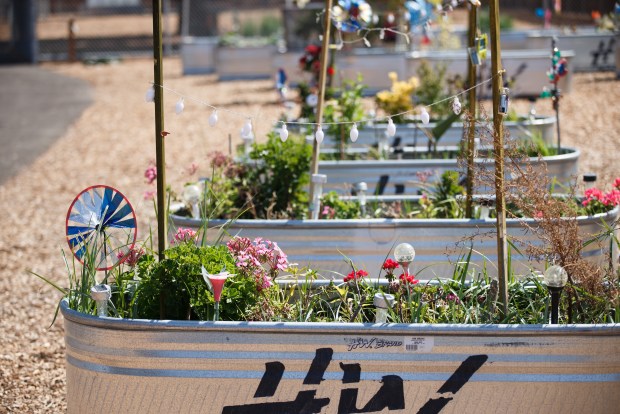
In his latest effort to combat the city’s persistent problem with homelessness, San Jose Mayor Sam Liccardo has plans to start work on 2,300 new homes for unhoused residents by the end of next year — in part by building hundreds more modular apartments scattered throughout the city.
Recommitting to a pandemic strategy he says is working, the mayor wants to open 683 new transitional beds for people awaiting permanent housing placements — effectively tripling the city’s current stock. His announcement comes as the city has seen a COVID-inspired influx in federal and state funding for homeless housing, and is poised to rake in even more in the coming months. Now, Liccardo is calling on City Council members to support his push and offer up sites for the apartments in their own districts.
While most of the 683 new units will be modular apartments, some will be in converted motels. Liccardo also hopes to add 1,384 units of city and county-funded permanent housing, and 239 units funded by the state’s Homekey program to house some of San Jose’s estimated 7,000 homeless residents.

“All told, it will take a very significant bite out of the crisis,” Liccardo said at a news conference Wednesday. “But we know the crisis is still larger. So we have to keep pushing, finding more resources.”
Liccardo’s announcement comes days after President Joe Biden’s administration announced a push to house 100,000 people by the end of 2022. Oakland, San Francisco and San Jose shared their own goals as part of the federal initiative, with Liccardo’s office tentatively saying the city would house 1,134 people and build 861 units. Liccardo upped those numbers Wednesday and provided details on how his administration would meet those goals.
In an effort to get people off the streets during the pandemic, San Jose already has opened three communities of pre-fab, modular apartments on Evans Lane, Rue Ferrari, and Monterey and Bernal roads. Permanent affordable housing can cost between $750,000 and $800,000 per unit to build, and take between four and five years, Liccardo said. Pre-fab apartments — which cost $100,000 and $110,000 per unit and take just months to build — are a good intermediate solution, he said.
Plans to open a new modular apartment site off West Mission Street near Guadalupe River Park are set to go before the City Council for a vote next month, and if approved, the project could begin construction within 60 days. Another new site is in the works in District 10 (the Almaden Valley area), Liccardo said.
The mayor estimates the city needs to find six more sites for modular apartments communities. He hopes to bring them before the City Council for a vote by June.

Those projects could help more people like 48-year-old Jaki Vantrease, who after being homeless since 2007, recently moved into the Rue Ferrari transitional housing community. On Wednesday, during a news conference with Liccardo at the Rue Ferrari site, Vantrease beamed as she announced that she and her husband had signed a lease for permanent housing and would be moving that day.]
“I want other people like myself to succeed,” she said.
Liccardo’s push for more transitional housing follows an effort by Councilman Matt Mahan to identify additional sites and to work with Santa Clara County to explore turning the County Fairgrounds into homeless housing. The city’s Rules Committee was set to discuss those items Wednesday afternoon, and potentially advance them to a full City Council vote.
There is significant money up for grabs to address homelessness. Through the American Rescue Plan — Biden’s COVID stimulus package — San Jose received 369 emergency housing vouchers and $3.2 million in housing grants. Gov. Gavin Newsom has made another $2.75 billion available for cities and counties to turn hotels and other buildings into homeless housing, plus $1 billion in additional funds for homeless housing and services.

San Jose also is addressing how it manages the massive homeless encampments that have sprung up on sidewalks and in parks and open spaces throughout the city. The City Council in March voted to prioritize removing encampments from around schools, while also drafting rules that dictate where unhoused people can and can’t camp. Those rules are set to come back before the City Council next month.
San Jose has tried out several new methods to address homelessness over the past few years, not all of which have worked smoothly. Last year, the city spent more than two months and $1.3 million trying to renovate dilapidated trailers donated by the state to house homeless residents, before abandoning the project. When the city opened a community of rudimentary tiny homes built by Habitat for Humanity volunteers — a project that took three years thanks to neighborhood opposition and other delays — residents were slow to move in, in part because of the city’s strict rules about who was eligible for placement. The city’s two Habitat for Humanity sites are fully occupied now, according to the city.
Plans for additional homeless housing are sure to meet pushback from neighbors who don’t want the projects in their communities. After San Jose opened an emergency safe RV parking site earlier this month for people who had been pushed off an encampment on Apple’s North San Jose property, neighbors began protesting and signing petitions calling for the site’s removal.
“These are challenging conversations,” Liccardo acknowledged Wednesday. “We have to have these conversations because we don’t have any other path. We have to go forward.”







